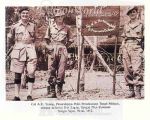We've tried to ensure the information displayed here is as accurate as possible. Should there be any inaccuracies, we would be grateful if you could let us know at info@ipohworld.org . All images and content are copyright.
(Please click on the thumbnail for a bigger image.)
Colonel A E Young Visits Fort Legap


The first photograph above shows the then Federated Malay States Police Commissioner, Colonel Arthur Edward Young, at Fort Legap in 1952. The second image, shows him in a more formal mode as a uniformed police officer.
Fort Legap was one of the 12 Police Field Force (PFF) Forts built as part of the government's anti Communist strategy during the Malayan Emergency and the first in Perak. Arthur Edwin Young, was the City of London Commissioner of Police at the time but deployed to Malaya over 1952/53 to strengthen the police force in their fight with the communists.
No. 20 Federal Police Jungle Company was raised within the Police Field Force with a clear objective to cultivate and protect the Orang Asli in areas of Perak and Pahang. The company was based in Ipoh under the command of Assistant Superintendent of Police, John West, and had a total strength of about 200 men.
20 Companyy built its first fort, Fort Jor, at the 18th mile on the Tapah-Cameron Highlands Road to protect and administer to the needs of the many hundreds of Orang Asli who sought refuge from Communist domination in Pahang. The second 20 Company fort was at Kuala Legap in deep jungle to the north of Lasah.
Orang Asli under the protection of Fort Jor from May 1952 were able to return to their ladangs in Pahang in September 1953. Their escort was a platoon of 20 Coy under the command of John Drysdale and members of the Aborigine Protection Department including Dara Singh.
An incident at Tanjong Rambutan in 1949 had awakened the authorities to Communist Terrorists determination to maintain control of the Orang Darat. This was the term used for aborigines at that time. Major Williams-Hunt, Adviser on Aboriginals, had settled a group from the Sungai Prah area into a camp opposite to and across the river from Tanjong Rambutan police station. One evening, about two hours after dark, a police constable became aware of unusual movement in the Orang Darat camp. He was fired at when he investigated and the police station soon came under heavy fire. The Communist Terrorists maintained the attack until all the Orang Darat were herded away from Tanjong Rambutan and back into the jungle.
From this incident the understanding was reinforced that winning over the aborigines to the government side was a strategic necessity. After the death of Williams-Hunt a new Protector of Aborigines was appointed: Richard Noone. His arguments and efforts to train Orang Asal, a later term for aborigines, in the use of firearms were so successful that in the final two years of the Malayan Emergency his squads eliminated more Communist Terrorists than the rest of the government forces combined.
The State Secretariat had once attempted a similar task establishing the Perak Auxiliary Aborigine Constabulary. Their numbers were about the same as 20 Company but it lacked a headquarters, an administrative base and transport. They sometimes worked with the Special Air Service but when four of their officers were ambushed and killed while rafting along the Sungai Plus in September 1951, their fort, Fort Lockham was abandoned. The role of the force was then to maintain contact with aboriginal headmen until it was absorbed into 20 Companyy in May 1952.
Click here for Fort Legap Scenes, Part 1
To read about the Malayan Emergenc, click here.
To read more about General Sir Gerald Templer, click here.
To read more about Richard O D (aka Dick) Noone, click here.
To read more about Auxiliary Police / Special Constables, click here.